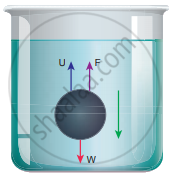Advertisements
Advertisements
प्रश्न
Derive the expression for the terminal velocity of a sphere moving in a high viscous fluid using stokes force.
उत्तर
Expression for terminal velocity: Consider a sphere of radius r which falls freely through a highly viscous liquid of coefficient of viscosity η. Let the density of the material of the sphere be ρ and the density of the fluid be σ.

Forces acting on the sphere when it falls in a viscous liquid
Gravitational force acting on the sphere,
FG = mg = `4/3π"r"^3ρ"g"` (downward force)
Upthrust, U = `4/3π"r"^3σ"g"` (upward force)
Viscous force, F = 6πηrvt
At terminal velocity vt,
Downward force = upward force
FG = U + F
FG − U = F ⇒ `4/3π"r"^3ρ"g" - 4/3π"r"^3σ"g"` = 6πηrvt
vt = `2/9 xx ("r"^2(ρ - σ))/η` g ⇒ `"v"_"t" ∝ "r"^2`
Here, it should be noted that the terminal speed of the sphere is directly proportional to the square of its radius. If a is greater than ρ, then the term (ρ – σ) becomes negative leading to a negative terminal velocity.
APPEARS IN
संबंधित प्रश्न
Fill in the blanks using the word(s) from the list appended with each statement
For solids with elastic modulus of rigidity, the shearing force is proportional to . . . , while for fluids it is proportional to . .. (shear strain / rate of shear strain)
A raindrop falls near the surface of the earth with almost uniform velocity because
The unit of viscosity is
A small sphere of radius 2 cm falls from rest in a viscous liquid. Heat is produced due to viscous force. The rate of production of heat when the sphere attains its terminal velocity is proportional to
A block of Ag of mass x kg hanging from a string is immersed in a liquid of relative density 0.72. If the relative density of Ag is 10 and tension in the string is 37.12 N then compute the mass of Ag block.
An incompressible liquid flows through a unifonn cross sectional tube with velocity 20 cm/s. If the thickness of liquid layer is 0.8 cm then velocity of gradient of flow is ____________.
State the formula and S.I. units of coefficient of viscosity.
Define velocity gradient.
A force of 0.01 N is required to move a flat glass plate of area of 10 cm2 with a uniform velocity of 1 cm/ s over the surface of a liquid 2 mm thick. If the coefficient of viscosity of the liquid is 20 poise, the velocity gradient in the liquid layer is ______.
The dimensions of coefficient of viscosity are ______.
